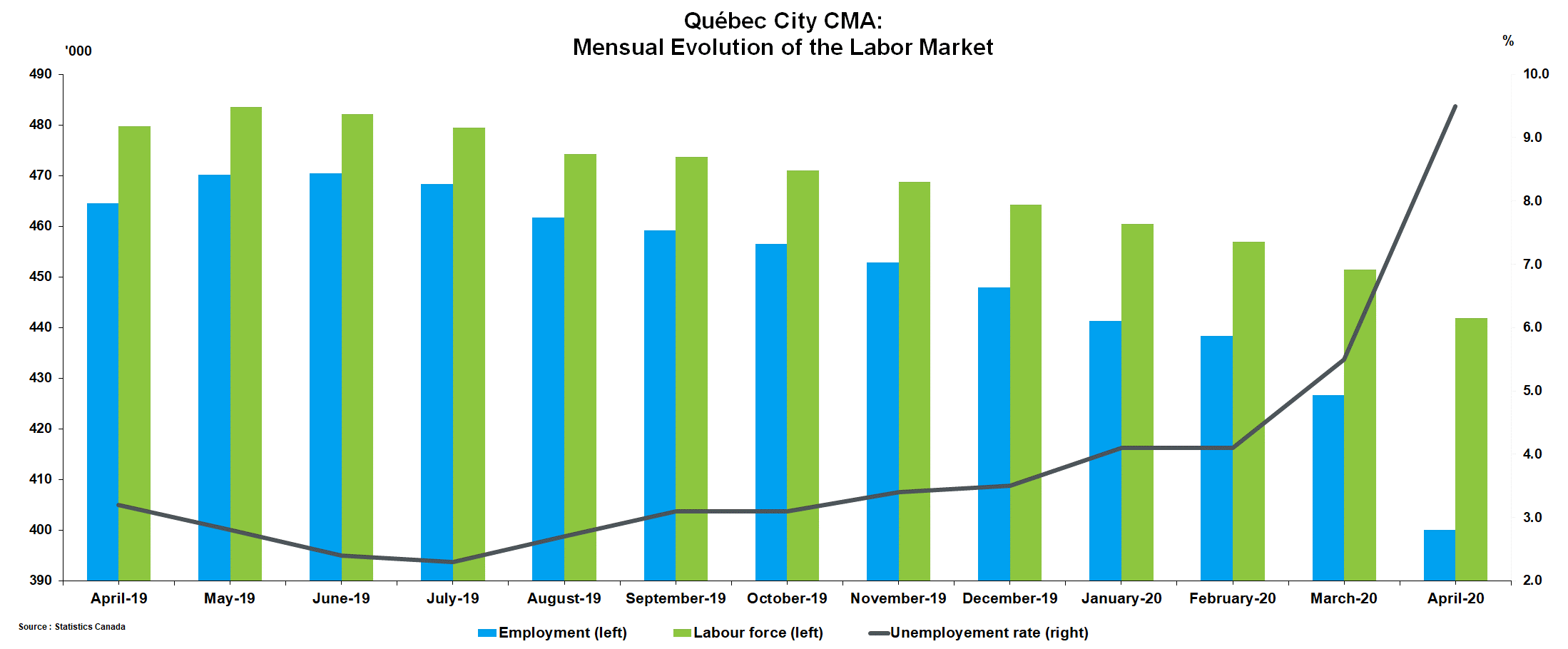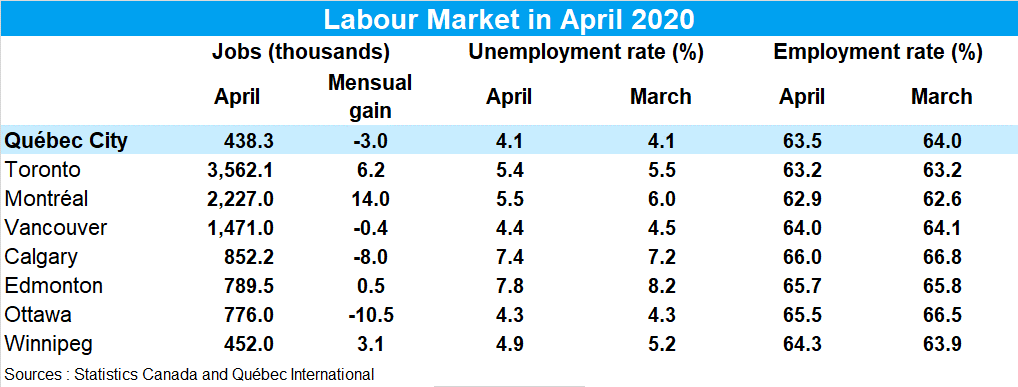Cautionary Note
The available data for the Québec City census metropolitan area (CMA) was given special treatment (three-month moving average) due to the small sample size, which mitigated the strong fluctuations in the data. The current situation causes extreme variations which cannot be fully observed with this data. Please note that we use comparable data for the province of Quebec and the other CMAs in this document.
April estimations in the Labour Force Survey (LFS) were established based on data collected from respondents during the reference week of April 12 to 18. In the province of Quebec, the restrictions on non-essential activities and services in accordance with the public health order were fully effective starting on March 25. Note that the labour estimations for the month of March were established based on data collected from respondents during the reference week of March 15 to 21, before the province was brought to a halt. Also note that landscaping and landscape maintenance, vehicle maintenance and repair, and mining development activities were added to the list of essential services and activities on April 15, during the LFS reference week for April. Residential construction activities were only authorized starting on April 20, after the reference week. LFS data for April gives a better view of the effects of the pandemic on the labour market compared to March data but still does not reflect the full extent or nuances of the economic halt.
Statistics Canada’s definition of “unemployment” is based on the activity of job search and the availability to take a job. Therefore, the definition of unemployed people are those who, during the reference week of April 12 to 18, were available to work and:
- were without work, but had looked for work in the past four weeks,
- were on temporary layoff with an expectation of recall, or
- were without work, but had a job to start within four weeks from the reference week.
To learn more, please visit: https://www150.statcan.gc.ca/n1/en/catalogue/71-543-G
Highlights
- According to the LFS, there were an estimated 400,000 people employed in the region in April, 26,600 fewer than in March (‑6.2%) and 38,300 fewer than in February 2020 (-8.7%). This decrease is attributable to the impacts of COVID-19.
- The number of unemployed people rose by 16,900 people (+67.9%) in April compared to March, an increase of 23,100 people (+123.5%) compared to February.
- According to Statistics Canada, the unemployment rate reached 9.5% in the Québec City CMA in April, an increase of 5.4 percentage points since the beginning of the crisis (February 2020).
- In the province of Quebec, comparable data shows a drop of 266,800 in the number of people employed in April compared to March (-6.2%), or 341,800 compared to February (-7.8%). The employment rate reached 9.7% in April.


Commentary
The province of Quebec has been on hold since March 25, and so has the region’s labour market. Labour Force Survey (LFS) data for April 2020, released by Statistics Canada, helps get a sense of the immediate impacts of the lockdown on the labour market. However, the available data for the Québec City CMA only offers a glimpse of the situation due to the complexity of the pandemic’s effects and the statistical treatment applied by Statistics Canada.
In April 2020, there were an estimated 400,000 jobs in the region, a 26,600 drop compared to March (-6.2%). This decrease, attributable to the effects of COVID-19, is even steeper when compared with February 2020: a decrease of 38,300 jobs (‑8.7%). The unemployment rate in the Québec City CMA reached 9.5%, a significant increase of 5.4 percentage points points since the beginning of the crisis (February 2020). The ratio of job searchers reached a level unseen since the early 2000s. Moreover, the impact of this pause is reflected in the number of people who left the labour force, which recorded a drop of almost 15,200 people (-3.3%) in April compared to February 2020. The exceptional circumstances seem to have supported this decrease, based on respondents who said they were neither employed nor in search of a job. As for unemployment, there were 16,900 more unemployed people (+67.9%) in April compared to March. When compared to February, this number jumps to 23,100 people (+123.5%). In addition, the employment rate (or employment-to-population ratio) fell from 63.5% in February to 57.9% in April. Note that in April 2019, this rate was growing and was 67.7% in the Québec City CMA.
The decline in the number of jobs in April affected all age categories of the population. However, like in the rest of the province, it is the younger age group (24 and under) that observed the strongest drop in employment and increase in unemployment. This group is highly represented in sectors where proximity with the public is significant. Incidentally, the biggest decline observed in April was in the accommodation and food services sector. The construction sector and educational services were also highly affected.
LFS data for the Québec City CMA gives an idea of the generalized shock linked to COVID-19. For example, the available data showed a strong decline in the number of hours worked from February to April, which is not accessible in the short term for the region. This decline was about 35% in the province of Quebec, compared to 28% in Canada. The much-anticipated gradual resumption of activities should be reflected in the data for the coming months. However, this will be dictated by the evolution of the crisis, and we will need to wait a long time before we see all the pandemic’s structural impacts on the labour market.
Émile Émond
Economist
Québec International



